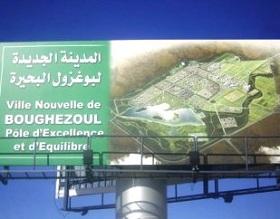Using AI to control energy for indoor agriculture
30 September 2024
Published online 23 December 2010

A newly unveiled project to build a sustainable, low-carbon city in Algeria promises to be a prototype for urban development in other cities of the developing world without adding to greenhouse gas emissions.
The new city of Boughzoul will be located inland, 200km south of the capital Algiers. The project is being spearheaded by the Global Environment Facility (GEF), which will provide 8.5 million USD, along with the United Nations Environment Programme (UNEP). The city is designed to have low-carbon emissions from the early stages of construction to the everyday running of the city.
"Urbanization is a fact of life happening today in developing countries. Today roughly half of the world's population lives in urban areas. This share is projected to reach 60% by 2030," said Monique Barbut, chief of the GEF.
"This means that cities of the developing world will welcome in the next 20 years more people than those living today in Europe and the US," she added.
This migration brings a series of new environmental issues. Cities emit nearly 70% of global energy-related carbon emissions. This number is expected to continue rising steadily, driven mainly by the transport and building sectors, explains Barbut.
"The design and development of the new town of Boughzoul is an opportunity to introduce best practices in architecture, building construction and urban planning," said Bernard Jamet, head of the technology transfer unit in the United Nations Environment Programme (UNEP).
It is hoped Boughzoul will become a bustling city of 400,000 residents after it is completed in 2025. The city's low-carbon construction should save 3.4 million tones of CO2 emissions compared to traditional construction and operation. According to Jamet, this is equivalent to about 600,000 tonnes of oil.
We need to make sure that research and development is promoted to make sure that whatever we learn from this experiment is shared and promoted.
"There are essentially two issues that we are addressing in the context of the project, adaptation and mitigation," said Chérif Rahmani, Algeria's minister of spatial planning and environment. "We hope that the experience we gain here while developing the city can be expanded to other cities in Algeria to contribute to the reduction of greenhouse gas emissions in the country."
For the city to succeed, Rahmani stresses the need to make it attractive to everyone, especially the private sector. A strong financing scheme, such as tax incentives, can attract private investors and generate a successful relationship between the private and public sectors. "We also need to have a clear monitoring system in place to make sure the city is properly managed," he adds.
In addition to zero-carbon buildings, LED-powered streetlights, photovoltaic systems and solar water heating systems, Boughzoul will also be home to a center of excellence for technology transfer.
"We need to make sure that research and development is promoted to make sure that whatever we learn from this experiment is shared and promoted in the rest of Algeria," said Rahmani.
Jamet is optimistic that the Boughzoul experiment can help develop methods and technologies that can then be scaled-up outside Algeria.
In addition to the funds secured by the GEF, the Algerian government will raise a further 22 million USD.
Besides Boughzoul, there are several other initiatives to develop low-carbon cities in other countries. The most prominent of these is Masdar, a zero-carbon city being built on the outskirts of Abu Dhabi in the United Arab Emirates. The first phase of Masdar will be habitable by 2015. It is also home to Masdar Institute of Science and Technology, which opened its doors in 2009 and focuses on research on clean energy.
doi:10.1038/nmiddleeast.2010.236
Stay connected: